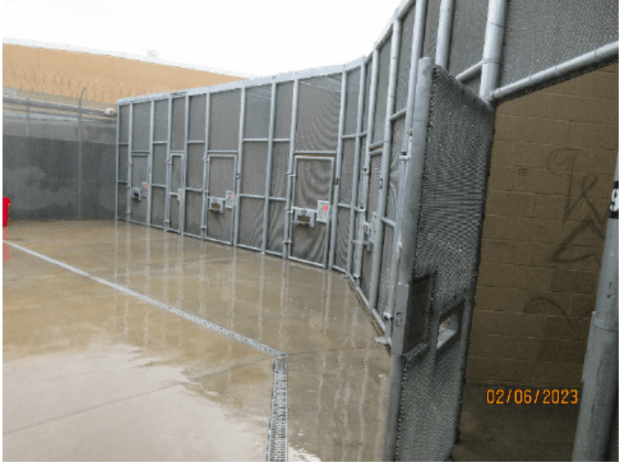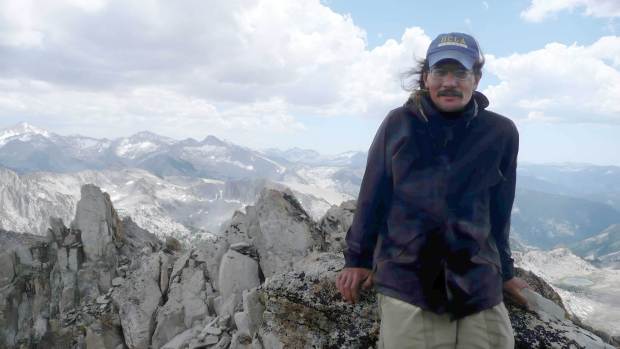Unit 5C inside the George F. Bailey Detention Facility, San Diego’s largest jail, resembles a typical jail module: white walls, concrete floors and two levels of cells with sea foam green doors. The unit’s large dayroom is dotted with bolted-down metal tables and stools.
But the dayroom is largely unused.
State regulations require jails to offer every person in custody at least 10 hours of weekly out-of-cell time — seven in a dayroom and three in a rec yard. In 5C, which houses people who’ve been placed in “administrative separation” due to a propensity for violence, each person spends their dayroom time alone in a small cage-like metal enclosure.
The caged area is connected to another cell and a small shower. There’s also a hands-free phone.
“Because no one is allowed in the dayroom, a person cannot even converse with another incarcerated person through their cell door; the lack of human contact is extreme,” wrote Dr. Pablo Stewart, a psychiatrist and expert witness in a class-action lawsuit seeking to improve conditions in San Diego jails.
“To be sure, this level of restriction and isolation is outside the norms of even the most restrictive solitary confinement units I have seen in other systems,” he wrote.
Stewart described 5C as “filled with people with serious mental illness.”
The San Diego County Sheriff’s Office says the enclosure, installed in 2014, offers a secure way to deliver out-of-cell time.
“The dayroom enclosure you refer to as a metal cage is a secure space designed to provide incarcerated persons assigned to administrative separation with structured out-of-cell time in a way that prioritizes both their well-being and facility safety,” a spokesperson told The San Diego Union-Tribune in January in an emailed response to questions.
“This enclosure allows individuals to access essential resources, including a shower and telephone, while also enabling them to remain in the dayroom area rather than returning to their cells each time staff conduct necessary duties, such as medication distribution, safety checks, meal distribution and the escorting of other individuals.”
A spokesperson did not respond to recent questions about whether a specific incident or trend led to the use of the enclosure.
But critics say the enclosure — and the broader system of isolation — constitutes a form of solitary confinement that exacerbates mental illness and makes the jail less safe overall.
“It’s like nothing I’ve ever seen in any prison or jail,” said Aaron Fischer, an attorney representing plaintiffs in the lawsuit, known as the Dunsmore case, who toured the unit with Stewart in February 2024.
Even time in the jail’s outdoor recreation yard involves being locked in a metal cage — an environment one man described to Stewart as worse than “even the most restrictive settings in the California state prison system.”
“The level of restriction and isolation is so severe,” Stewart wrote of 5C, “that it undermines the provision of any meaningful mental health treatment.”
 The only way a person can be in the outdoor rec yard at the George Bailey Detention Facility is if they’re locked in a metal enclosure. (Courtesy Aaron Fischer)
The only way a person can be in the outdoor rec yard at the George Bailey Detention Facility is if they’re locked in a metal enclosure. (Courtesy Aaron Fischer)
The men Stewart spoke to said they rarely left their cells. Some hadn’t showered in weeks. One man, held there for three weeks, told him he didn’t even know there was a recreation yard.
The Union-Tribune sent photos of the enclosure to several experts in correctional mental health care and jail oversight. None had seen such a thing used in a dayroom.
Sheren Barboza, a psychologist with more than two dozen years of experience working in correctional settings, described administrative separation as “awful,” but said she understood the utility of the dayroom enclosure.
“Having that enclosure might allow them to have some sort of dayroom and still be able to move other folks as needed because there’s that sort of cage to protect them,” she said. “I don’t love it, but I can understand the use of it, because it really does allow them sort of to do two things at once, which they sometimes can’t do.”
Clinician Aseel Ross, who worked in 5C from January 2022 until September 2023, testified during a deposition in the Dunsmore lawsuit that many people placed in administrative separation didn’t need to be there from a clinical perspective.
“They were in ad-sep because they are a danger to the general population or a serious incident happened,” Ross testified. “That is a result, unfortunately, sometimes from their mental health.”
Ross saw firsthand how prolonged isolation impacted her patients. Most mental health interactions, she said, occurred cell-side and were limited to “quick things,” like checking on sleep or mood.
She said she proposed a treatment program that would phase people out of segregation through structured group activities, like art and music therapy and classes in coping skills.
The idea had support from some jail officials, she said, but mental health leadership never approved it. In his report, Stewart described Ross’ proposal as a missed opportunity.
Experts say that similar programs have shown success elsewhere in California.
In Kern County, for example, nearly 300 people were once housed in administrative separation — roughly 20% of the jail population. Today, that number is fewer than 10. Officials accomplished this by re-evaluating risk, putting strict limits on how long a person can be held in isolation and expanding behavioral health programs.
Other counties, including Sacramento and San Mateo, have seen similar successes by offering people who’d otherwise be in isolation daily therapy, group sessions and more out-of-cell time. The result, officials and experts say, is less violence and better outcomes.
Patrick Booth, an attorney with Prison Law Office, which launched the Solitary Confinement Reform Project with advocacy group Disability Rights California in 2023, said counties that have successfully reduced their use of administrative separation were initially skeptical.
“‘We didn’t think this was going to work when we started, and we thought there was going to be mass violence, and that hasn’t happened. Our staff seemed to like it more.’ Those are the kinds of comments that we get,” he said. “When you do something different, when you start letting people have pro-social opportunities, violence in a jail usually goes down.”
So far, the project has helped some counties reduce their administrative separation populations by up to 90% through limiting isolation to cases of recent violence and banning the use of restrictive housing for people with serious mental illness.
 Matthew Settles’ family says that despite his history of suicide attempts and need for intensive psychiatric care, jail staff placed him in isolation and failed to ensure he took his prescribed medications. He died in custody in 2022. (Settles family)
Matthew Settles’ family says that despite his history of suicide attempts and need for intensive psychiatric care, jail staff placed him in isolation and failed to ensure he took his prescribed medications. He died in custody in 2022. (Settles family)
“In many jails, there’s a tendency to overestimate risk,” said Prison Law Office Executive Director Margot Mendelson. “But when you stop punishing people for symptoms of their illness and instead offer treatment, you see less violence, better behavior and safer conditions for staff.”
A Sheriff’s Office spokesperson said individuals in administrative separation are assessed weekly to determine whether they can be safely moved to a less-restrictive unit.
But such reviews, conducted by custodial staff, lack clinical oversight and result in people remaining in isolation indefinitely, advocates say.
Matthew Settles was one such person. He died by suicide on Aug. 17, 2022, while housed in 5C. Records show he was rarely out of his cell, and nearly all of his mental health care occurred at the cell door. After his death, others in the unit told investigators they had never seen or spoken to him.
Settles had a history of self-harm and was jailed after attacking a patient and security guard at a psychiatric hospital. He was initially held in the Central Jail’s psychiatric security unit before being transferred to George Bailey a month before his death.
He was placed in administrative separation “due to a propensity for violence and a failure to adhere to minimum jail standards,” records show. Yet a note from a homicide investigator said Settles “had exhibited no negative behavior since 7/15/22.”
His family has filed a lawsuit against the county, arguing he never should have been placed in restrictive housing.
